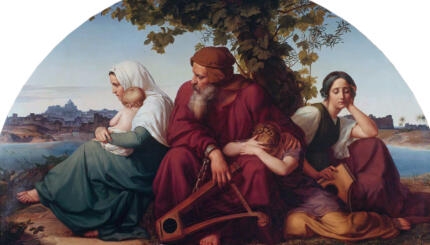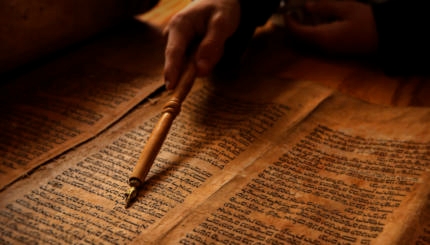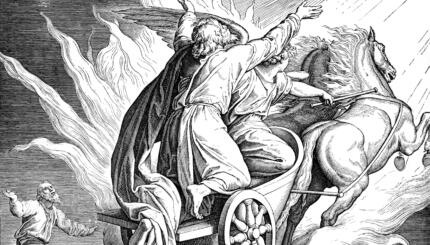Commentary on Parashat Vayera, Genesis 18:1-22:24
Two cosmic catastrophes unfold in the book of Genesis. The first, the flood, in which God brings waters down from the Heavens to destroy almost all life. The second, the utter devastation of Sodom and Gomorrah, in which an area previously known as a fertile and lush “garden of Hashem” (Genesis 13:10) becomes a desolate land “that cannot be sown, nor sprout, and no grass shall rise up upon it, like the upheaval of Sodom and Gomorrah…which God overturned in His anger, and His wrath” (Deuteronomy 29:22).
One of the connections we see between these two events is the word the Torah employs in both cases, lihashcheet–to destroy. When God relates to Noah that He will bring the flood He says, “The end of all flesh has come before Me; for the earth is filled with robbery through them; and, behold, I am about to destroy (mashcheetam) them from the earth” (Genesis 6:13).
In the case of Sodom we see the same word applied, “…when God destroyed (beshachet) the cities of the plain…” (Gen. 19:29). The Torah did not elaborate on the sin of Sodom, but the underpinnings are expressed later in the prophecy of Ezekiel: “Behold this was the sin of Sodom…She and her daughters had pride, excess bread, and peaceful serenity, but she did not strengthen the hand of the poor and the needy” (16:49).
What Did They Do?
The prophet’s description combined with what the Torah reveals to us gives us the following picture: the people of Sodom insisted on preserving their high quality of living to such an extent that they established a principle not to let the poor and homeless reside in their city. Consequently when a destitute person would come seeking help, they would revoke his right to any welfare–public or private! By doing this they figured they would preserve an elite upper class community who would monopolize the profits that the bountiful land offers without having to distribute any revenues to a “lower class” of people.

Help us keep Jewish knowledge accessible to millions of people around the world.
Your donation to My Jewish Learning fuels endless journeys of Jewish discovery. With your help, My Jewish Learning can continue to provide nonstop opportunities for learning, connection and growth.
An opinion in the Mishnah in Avot 5:10 further strengthens this picture of moral depravity when it defines the Sodomite as one who says, “What’s mine is mine and what’s yours is yours.” The Mishnah decries a man who wishes to remove himself from the social responsibility of welfare by closing himself and his wealth from others, even if he makes the claim that he is not taking away from anyone else.
Interestingly, the Sages of the Talmud did not merely draw attention to the relationship between the economic injustices of the generation of the flood and the social depravity of Sodom. The Torah narrative concerning Sodom reveals something deeper. “They called out to Lot, ‘Where are the men that came to you tonight? Bring them out to us that we may know them!'” (Gen. 19:5) Indeed, the men demanded to relate to Lot’s male guests sexually. According to the Midrash in Genesis Rabbah 28:8, the destruction caused by the flood also shared a similar cause:
“Rabbi Azariyah said in the name of Rabbi Yehoshua son of Simon, every creature had been corrupted in the generation of the flood. The dog would mate with the wolf, the hen with the peacock. For it is written, ‘All flesh was corrupted.’ ‘All mankind was corrupted’ is not written, rather ‘All flesh was corrupted.’ (Thereby coming to include all flesh, both human and animal.) Rabbi Luliyani son of Tavrin said in the name of Rabbi Isaac, ‘Even the land became corrupt as they would sow wheat and the land would sprout degenerate wheat.'”
Sins Against the Environment
Until now, we have dealt with sins between people and God (sexual immorality) and between people and society (robbery, excluding the poor) — yet our Torah portion even makes references to sins between man and his environment. The Torah again uses the verb hashchata in relation to the wanton destruction of fruit trees: “When you besiege a city to seize it, do not destroy (tashchit) its trees by swinging an axe against them, for from it you will eat, and you shall not cut it down; is the tree of the field a man that it should enter the siege before you?” (Deut. 20:19)
A final example: the same Hebrew verb hishchit is used in regards to the widely accepted Law delineated in the Book of Mitzvot not to destroy any part of our world. Under the above-stated commandment not to destroy fruit trees in a siege, comes a further negative commandment where we are forbidden to waste.
For example, we must not tear or burn clothing or break or discard dishes for no reason. About all of these issues or any other issues of wanton destruction, the Sages of blessed memory said in the Talmud, “And he has transgressed the sin of being a wasteful man” (The Book of Mitzvot #529).
Sodom’s Unsustainability
What could be the connection between the corruption of the generation of the flood, the people of Sodom, and environmental sins? There are three basic answers. The first and most simple reason is that humanity itself is part and parcel of its environment and is not separate from it. Having been created in the image of God we may think that we are detached from creation. Further, our Torah-given obligation to preserve the world that God gave us may suggest to us that we are above it.
Nonetheless, we are bound to and part of creation. The Torah stresses this by including the creation of human beings in the six days of creation and creating us with the means to sustain ourselves like all other creatures, regardless of our unique stature of being created in the image of God. Consequently, when one sins against a fellow creature — human or animal — they are sinning against their environment.
The second connection between the flood, the people of Sodom, and the destruction of our environment is that in those generations the people corrupted their sexual power. Sexual power can build worlds or destroy them. Statements by the Sages that the flood was a result of the inbreeding of species may be applied to our present era as a warning of possible destruction caused by various genetic experimentation, which although at times may be morally justified and halakhically permissible, in other situations can be destructive and wrong, and we must be careful in what we allow and what we do not.
The most central point in the connection between moral behavior and environmental behavior comes from the understanding that both behaviors go hand in hand. One without the other corrupts the Divine vision for human action. That is, a society may be passionate about preserving its natural environment while maintaining a complete disregard for the welfare of its citizens. Sodom is a perfect example of this, where they cared so much for their “garden of Hashem” that they refused to aid anyone in need.
In conclusion, our Torah portion provides deep insights into living in balance with one’s environment. The people of Sodom’s perverted ways, in effect, were extremely unsustainable–causing God to turn one of the most fertile and lush ecosystems on Earth into what today is infamous for its barrenness and desolation. From the mistakes of the people of Sodom we can learn the essential character traits that allow one to live in balance with the Creator and creation.
The moral human being is devoted to the holiness and purity of life, refrains from harming others, lives a sexually responsible lifestyle, and sacrifices personal pleasure for an ethical and upright path. When we are capable of fulfilling this ideal we will naturally be triumphant in attaining the great spiritual task of infusing our religious/moral lifestyle with one that is also environmentally sustainable.
May we all be blessed to undertake the task.
Provided by Canfei Nesharim, providing Torah wisdom about the importance of protecting our environment.
Avot
Pronounced: ah-VOTE, Origin: Hebrew, fathers or parents, usually refering to the biblical Patriarchs.

Help us keep Jewish knowledge accessible to millions of people around the world.
Your donation to My Jewish Learning fuels endless journeys of Jewish discovery. With your help, My Jewish Learning can continue to provide nonstop opportunities for learning, connection and growth.
Midrash
Pronounced: MIDD-rash, Origin: Hebrew, the process of interpretation by which the rabbis filled in “gaps” found in the Torah.

Help us keep Jewish knowledge accessible to millions of people around the world.
Your donation to My Jewish Learning fuels endless journeys of Jewish discovery. With your help, My Jewish Learning can continue to provide nonstop opportunities for learning, connection and growth.
Mishnah
Pronounced: MISH-nuh, Origin: Hebrew, code of Jewish law compiled in the first centuries of the Common Era. Together with the Gemara, it makes up the Talmud.

Help us keep Jewish knowledge accessible to millions of people around the world.
Your donation to My Jewish Learning fuels endless journeys of Jewish discovery. With your help, My Jewish Learning can continue to provide nonstop opportunities for learning, connection and growth.
Talmud
Pronounced: TALL-mud, Origin: Hebrew, the set of teachings and commentaries on the Torah that form the basis for Jewish law. Comprised of the Mishnah and the Gemara, it contains the opinions of thousands of rabbis from different periods in Jewish history.

Help us keep Jewish knowledge accessible to millions of people around the world.
Your donation to My Jewish Learning fuels endless journeys of Jewish discovery. With your help, My Jewish Learning can continue to provide nonstop opportunities for learning, connection and growth.
Torah
Pronunced: TORE-uh, Origin: Hebrew, the Five Books of Moses.

Help us keep Jewish knowledge accessible to millions of people around the world.
Your donation to My Jewish Learning fuels endless journeys of Jewish discovery. With your help, My Jewish Learning can continue to provide nonstop opportunities for learning, connection and growth.


